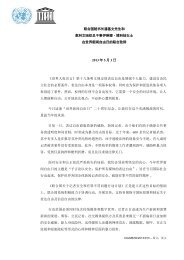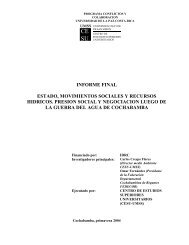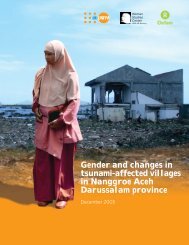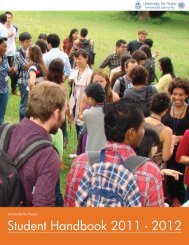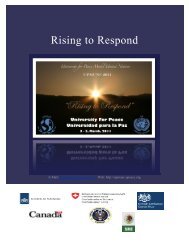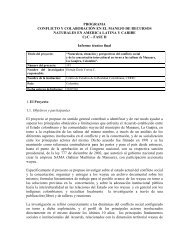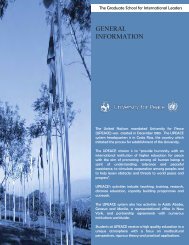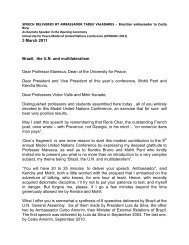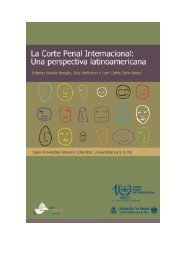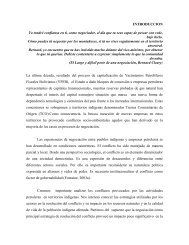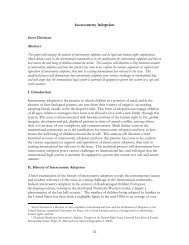A DEEPER LOOK AT VIOLENCE AGAINST WOMEN - Peace and ...
A DEEPER LOOK AT VIOLENCE AGAINST WOMEN - Peace and ...
A DEEPER LOOK AT VIOLENCE AGAINST WOMEN - Peace and ...
You also want an ePaper? Increase the reach of your titles
YUMPU automatically turns print PDFs into web optimized ePapers that Google loves.
A <strong>DEEPER</strong> <strong>LOOK</strong> <strong>AT</strong> <strong>VIOLENCE</strong> <strong>AGAINST</strong> <strong>WOMEN</strong> (VAW): THE PHILIPPINE CASE 1<br />
“Violence against Women is perhaps the most shameful human rights violation. It knows no boundaries<br />
of geography, culture or wealth. As long as it continues, we cannot claim to be making real progress<br />
towards equality, development <strong>and</strong> peace.”<br />
I. Naming <strong>and</strong> defining the problem<br />
‐ Kofi Annan, United Nations General Assembly<br />
New York, 5‐9 June 2000<br />
The United Nations decade for Women (1976‐1985) brought to the fore the issue of genderbased<br />
violence, particularly violence against women (VAW). This phenomenon, which was<br />
previously regarded as rare or non‐existent, was given focal attention as its incidence all over<br />
the world became very alarming.<br />
Variously referred to as “sexual violence”, “gender violence“ or “violence against women“, this<br />
age‐old issue <strong>and</strong> reality has gained urgency only recently because of the significant work of<br />
women advocates <strong>and</strong> survivors in naming the problem. It includes domestic violence, rape,<br />
trafficking in women <strong>and</strong> girls, forced prostitution, <strong>and</strong> violence in armed conflict, such as<br />
murder, systematic rape, sexual slavery <strong>and</strong> forced pregnancy. It also includes honor killings,<br />
dowry‐related violence, female infanticide <strong>and</strong> prenatal sex selection in favor of male babies,<br />
female genital mutilation, <strong>and</strong> other harmful practices <strong>and</strong> traditions. These forms show that<br />
violence against women maybe viewed in a “continuum” occurring at various life cycle stages<br />
of a woman’s life.<br />
Such violence arise from a “complex interaction between, on one h<strong>and</strong>, pervasive political <strong>and</strong><br />
social structures in which women generally have less power than men, <strong>and</strong> on the other,<br />
individual responses to these structures.” This imbalance in power relationship between<br />
women <strong>and</strong> men often means that men are influenced by their notions of masculinity, including<br />
the use of <strong>and</strong> acceptance of violence in various aspects of his life including within the context<br />
of relationships with women.<br />
VAW is closely linked with the unequal power relationship between women <strong>and</strong> men<br />
otherwise known as “gender‐based violence.” It is related to how women <strong>and</strong> men feel,<br />
experience <strong>and</strong> think about the world around them, perceptions that are influenced by the<br />
system of power <strong>and</strong> how organization, policies, norms <strong>and</strong> behaviors support those systems in<br />
different contexts. It is rooted in ideas of what it means to be a woman, <strong>and</strong> what it is to be man;<br />
in the notion that men are entitled to certain types of power; <strong>and</strong> in the consequences that ensue<br />
when that entitlement is thwarted.<br />
The UN Declaration on the Elimination of Violence against Women (1993) defines violence<br />
against women as, “any act of gender‐based violence that results in, or is likely to result in,<br />
1<br />
By Grace N. MallorcaBernabe from the Philippines<br />
1
physical, sexual or psychological harm or suffering to women, including threats of such acts,<br />
coercion or arbitrary deprivation of liberty, whether occurring in public <strong>and</strong> private life.”<br />
Two years later, this issue was further reiterated as one of the twelve critical areas of concerns in<br />
the Beijing Declaration‐Fourth World Conference on Women, known as the Beijing Platform for<br />
Action.<br />
II. Socio‐Cultural <strong>and</strong> Political Contexts of VAW in Asia<br />
Social <strong>and</strong> political contexts such as class, race, ethnic group <strong>and</strong> sex, as well as individual<br />
circumstances, may vary <strong>and</strong> or exacerbate the extent <strong>and</strong> magnitude of violence against<br />
women.<br />
In Asia, as elsewhere in the world, the impact of grinding poverty brought about by economic<br />
globalization <strong>and</strong> various forms of fundamentalism are two phenomena in the Asia Pacific that<br />
have significantly influenced the context in which violence against women takes place <strong>and</strong> on<br />
how states have responded to VAW.<br />
The aggressive push for trade liberalization has led to economic as well as cultural dislocations<br />
of rural <strong>and</strong> indigenous women in the Asia Pacific Region. Large‐scale commercial extractive<br />
industries such as mining, logging <strong>and</strong> power generation by multinational corporations have<br />
led to the loss of l<strong>and</strong>, traditional sources of livelihood, <strong>and</strong> have worsened the state of food<br />
security. These have contributed to the increase of cheap female labor <strong>and</strong> a staggering increase<br />
in the feminization of migration. In Hong Kong, the number of foreign domestic helpers (a<br />
majority coming from the Philippines, Indonesia <strong>and</strong> Thail<strong>and</strong>, all women) was 237,110 for the<br />
year 2002.<br />
The feminization of poverty, alongside the pervasive social <strong>and</strong> cultural practices that<br />
discriminate against women, limit their opportunities <strong>and</strong> access to economic <strong>and</strong> political<br />
resources. In Asia Pacific, there are numerous cultural practices that are discriminatory towards<br />
women <strong>and</strong> which perpetuate forms of violence against women. The cultural <strong>and</strong> religious<br />
leaders, who are predominantly men, hold tremendous power <strong>and</strong> influence in their societies to<br />
interpret cultural <strong>and</strong> religious traditions in ways that perpetuate discrimination <strong>and</strong> violence<br />
against women.<br />
Within the context of social <strong>and</strong> ethnic or religious divisions, these anti‐women practices are<br />
justified as a means for asserting the community’s cultural <strong>and</strong> political identity. Women <strong>and</strong><br />
women’s bodies are the common terrain upon which cultural interpretations <strong>and</strong> assertions of<br />
power are played out ‐ whether it be over women’s clothes, reproductive rights, intimate<br />
relationships, social roles or rights to l<strong>and</strong> <strong>and</strong> other resources. In its report on the communal<br />
violence in Gujarat, India in 2002, the National Human Rights Commission of India concluded<br />
that there was a comprehensive failure of the state to protect the people which resulted in<br />
numerous accounts of violence against Muslim women, including rapes, torture, <strong>and</strong> killings.<br />
2
Women have become more vulnerable to violence, especially in conflict areas, <strong>and</strong> have become<br />
displaced persons in some parts of the Philippines, India <strong>and</strong> Pakistan as well as Burma, <strong>and</strong><br />
asylum seekers in transit <strong>and</strong> receiving countries. The increased militarization in many Asian<br />
countries has been supported by increased allocations in national budgets for military purposes<br />
<strong>and</strong> subsequent reductions in budgets for expenditures on health <strong>and</strong> education for women.<br />
III. Violence Against Women: Extent <strong>and</strong> Magnitude<br />
VAW is a worldwide phenomenon. The World Health Organization (WHO) reports that half of<br />
all women who die from homicide are killed by their current or former husb<strong>and</strong>s <strong>and</strong> partners.<br />
They succumbed to gunshot wounds, burns, hemorrhages <strong>and</strong> other physical injuries resulting<br />
from various forms of abuse.<br />
In the United States, the National Center for Victims of Crime, a leading resource <strong>and</strong> advocacy<br />
organization for crime victims, reports that ten percent of violent crimes in 2003 were<br />
committed by the victim’s intimate partner. Nineteen percent (19 percent) of women were<br />
victimized by intimate partners, a greater rate than men (3 percent).<br />
In the Philippines, while the documentation of all forms of VAW has yet to be achieved, existing<br />
data indicate that VAW is a pervasive social problem. Due to the sensitivity of the issues <strong>and</strong> its<br />
impact on women <strong>and</strong> their families, many cases of violence against women often go<br />
unreported.<br />
The Philippine National Police (PNP) documented a total of 1,100 to 7,383 cases of VAW from<br />
1996 to 2004. The highest record was in 2001 at 10,343. Cases reported included physical<br />
injuries, wife battering <strong>and</strong> rape (incestuous <strong>and</strong> attempted).<br />
The Department of Social Welfare <strong>and</strong> Development (DSWD) however, saw a general decline in<br />
the number of women in especially difficult circumstances (WEDC) cases served from 7,763 in<br />
1999 to 5,559 in 2004. Likewise, the number of child abuse cases also declined from 11,045 in<br />
2000 to 9, 197 cases in 2004.<br />
For the first three quarters of 2005, there were 4, 240 VAW cases reported to the PNP <strong>and</strong> 2,826<br />
WEDC cases served by the DSWD. Both the police <strong>and</strong> social welfare records show that<br />
battering <strong>and</strong> rape were the most common types of reported VAW cases.<br />
From 1993 to December 2002, there were around 1,013 Recorded Cases of Human Trafficking<br />
(DFA/CFO). 1999 accounted for 36.1 percent of the cases while 2000 accounted for 13.2 percent<br />
of the cases. Out of 460 responses, it has been noted that most of the victims came from Region<br />
III (26.5 percent); Region IV (17.8 percent); <strong>and</strong> the National Capital Region (16.5 percent). 64.5<br />
percent were women victims <strong>and</strong> 19.1 percent of the women victims were forced into<br />
3
prostitution. 51.8 percent were trafficked/smuggled to Asia‐Pacific; 26 percent to the Middle<br />
East; <strong>and</strong> 18.3 percent to Europe.<br />
Poverty <strong>and</strong> the absence of alternative sources of income push women into prostitution where<br />
they are exploited by brothel owners <strong>and</strong> pimps. Unscrupulous operators in tourism <strong>and</strong><br />
entertainment industries continue to exploit women for prostitution, bride matching <strong>and</strong><br />
pornography.<br />
As a country with the highest number of women working overseas (about 500, leave the<br />
country for work each year), migration–related violence has become an important issue in the<br />
Philippines. The vulnerabilities of women suffered in their home country are compounded in a<br />
setting where they are seen as temporary workers working in occupations considered socially<br />
inferior for nationals. There are numerous cases of sexual <strong>and</strong> physical abuse of domestic<br />
helpers in the Middle East, as well as destination countries in Asia. Entertainers experience<br />
sexual harassment <strong>and</strong> pressure to provide sexual services to customers. Where there are no<br />
mechanisms <strong>and</strong> infrastructure for relief <strong>and</strong> assistance victims are simply left to suffer their<br />
fate.<br />
IV. Impacts of Violence Against Women<br />
Violence against Women as a Human Rights Violation. Violence against women occurs when<br />
the human rights of women are violated, such as when women are physically injured, raped,<br />
beaten, held captive, or forced to work or provide services against their will. When women are<br />
trapped in violent marriages or homes, repeatedly battered, verbally abused <strong>and</strong> completely<br />
under the control of their husb<strong>and</strong>s or partners, that is violence against women. The physical,<br />
mental <strong>and</strong> emotional abuse that women suffer from as a result of violence have a tremendous<br />
impact on the health <strong>and</strong> well being of women.<br />
Abused women are more likely to suffer from depression, anxiety, psychosomatic symptoms,<br />
eating problems, sexual dysfunction <strong>and</strong> reproductive health complications. Violence may<br />
affect the reproductive health of women through the transmission of sexually transmitted<br />
diseases <strong>and</strong> HIV/AIDS. Unplanned pregnancies may sometimes become risk factors <strong>and</strong> lead<br />
to more aggression <strong>and</strong> abuse. Effects of violence maybe fatal as a result of severe injury,<br />
homicide or suicide.<br />
VAW has also become a development issue because it is an obstacle to the achievement of<br />
equality, security, liberty, integrity, <strong>and</strong> dignity of all human beings. It constrains human<br />
development, economic growth, <strong>and</strong> productive capacity. It is also a drain on financial<br />
resources. The direct costs include medical care; treatment programs for survivors <strong>and</strong><br />
perpetrators; shelters; courts <strong>and</strong> legal services to prosecute perpetrators; loss of productivity;<br />
increased mortality; training costs for personnel in the service provider system such as police,<br />
judges, nurses, medical doctors, social workers, <strong>and</strong> counselors; <strong>and</strong> other indirect social costs<br />
to family members of survivors <strong>and</strong> perpetrators. These costs have an impact on the economic<br />
4
growth of the country. The Inter‐American Development Bank (IDB) indicates that the costs of<br />
domestic violence reach 14.2 percent of GDP for the Latin American Region, including lost<br />
productivity, medical <strong>and</strong> legal costs, <strong>and</strong> the associated stress on families. In the USA, the costs<br />
of intimate partner violence are estimated at US $5.8 billion per year.<br />
Further, working women who suffer physical, psychological or sexual violence at the h<strong>and</strong>s of<br />
their partners earn less in general than women who do not suffer domestic violence (DV). The<br />
productivity of women is affected due to the high absenteeism caused by domestic violence.<br />
The IDB estimates that countries in Latin America lose 1.6 percent‐2 percent of GDP due to DVrelated<br />
loss of wages alone. This drain on a country’s finances is made worse by the strain that<br />
domestic violence places on women’s health ‐for every five years that a woman suffers domestic<br />
violence, she will lose one year of healthy life. In the Philippines, the government spends an<br />
estimated 6 billion pesos (P/6b) for the medical <strong>and</strong> psychological interventions for VAW<br />
V. Some Philippine Initiatives / Progress on the Elimination of Violence Against Women<br />
In the Philippines, tremendous <strong>and</strong> significant progress has been made in addressing <strong>and</strong><br />
eliminating violence against women by both government <strong>and</strong> non‐government organizations.<br />
Legislation, policies <strong>and</strong> action programs<br />
Some of the more significant laws passed were RA 8353 (or the Anti‐Rape Law) <strong>and</strong> RA 8505 of<br />
the Rape‐Victim Assistance <strong>and</strong> Protection Act; the Anti Sexual Harassment Law (or RA 7877)<br />
<strong>and</strong> the Anti‐Trafficking of Persons Law. The Family Courts Act of 1997 (RA 8369) established<br />
family courts in major cities all over the country. It is expected to foster a more proactive<br />
approach to protecting the rights of women <strong>and</strong> children against domestic violence <strong>and</strong> incest.<br />
The Department of Justice Memor<strong>and</strong>um No. 9 series of 1998 on the Guidelines on the<br />
H<strong>and</strong>ling of Rape Cases Involving Adult Victims was adopted. Relevant features of the policy<br />
include ensuring the fair <strong>and</strong> respectful treatment of the adult rape victim, assignment of a<br />
woman investigator during preliminary inquest, prevention of admission of evidence of the<br />
victim’s past sexual conduct or reputation unless such evidence is material <strong>and</strong> relevant to the<br />
case, <strong>and</strong> banning of the public during the conduct of the preliminary investigation. This is<br />
pursuant to RA 8505 or the Rape‐Victim Assistance <strong>and</strong> Protection Act.<br />
Local governments of City <strong>and</strong> Province of Cebu have shown that local legislative bodies can<br />
use their power of legislation to address domestic violence. The Cebu City Council, as well as<br />
the Provincial Board, passed ordinances penalizing domestic violence <strong>and</strong> providing protective<br />
measures for women <strong>and</strong> child victims of abuse. Among the more notable features of the<br />
provincial ordinance is the “barangay protection order” (BPO) which may be issued by the<br />
barangay chair upon petition of the victim. The BPO makes it possible for local officials to<br />
“remove <strong>and</strong> exclude (the abuser) from the residence of the abused person temporarily for the<br />
purpose of protecting the victim regardless of the ownership of the residence.” The protection<br />
5
order is deemed necessary because it is usually the wife <strong>and</strong> children who are compelled to<br />
leave the family home to escape the abusive husb<strong>and</strong>. This protection order is one of the<br />
important features of the new on law on VAW.<br />
In May 2003 President Macapagal‐Arroyo signed into law Republic Act 9208 or the Anti‐<br />
Trafficking in Persons Act. This was the result of advocacy strategies <strong>and</strong> intensified advocacy<br />
campaigns executed by NCRFW with support from members of the VAWCC <strong>and</strong> women<br />
NGOs. This is a comprehensive law that institutes policies to eliminate trafficking in persons,<br />
especially women <strong>and</strong> children, establishes necessary institutional mechanisms to protect <strong>and</strong><br />
support trafficked persons, <strong>and</strong> sets sanctions <strong>and</strong> penalties to traffickers, those who facilitate<br />
trafficking, <strong>and</strong> those who buy or engage the services of trafficked persons for prostitution. The<br />
law provides for a penalty ranging from 20 years imprisonment to life imprisonment <strong>and</strong> fine<br />
from P1million to P5million for offenders. It likewise provides for the protection <strong>and</strong><br />
rehabilitation of survivors by according them temporary shelter, health care, legal assistance,<br />
<strong>and</strong> counseling. Customers of trafficked women will also be penalized with community service<br />
or imprisonment <strong>and</strong> a fine. NCRFW played a major role in the finalization of implementing the<br />
rules <strong>and</strong> regulations. The Philippines was also cited as the country with the best practice in<br />
enacting a trafficking law at the Asia‐Europe Meeting (ASEM) Seminar on “Enhancing Support<br />
<strong>and</strong> Cooperation for Strengthening Policies to Assist Trafficked Women <strong>and</strong> Children” held in<br />
Bangkok, Thail<strong>and</strong> (September, 2003).<br />
Another milestone in the advocacy to eliminate VAW was the passage of Republic Act No. 9262<br />
or the Anti‐Violence Against Women <strong>and</strong> Their Children Act of 2004. This was signed into law<br />
last March 8, 2004 during the celebration of “International Women’s Day.” It penalizes all forms<br />
of abuse <strong>and</strong> violence within the family <strong>and</strong> intimate relationships.<br />
RA 9262 penalizes the commission of violence against women <strong>and</strong> their children (VAWC). It<br />
defines VAWC as any act or series of acts committed by any person against a women who is his<br />
wife or former wife, or with whom the person has or had a sexual dating relationship, or with<br />
whom he has had a common child. Additionally, it provides for penalties for violence<br />
committed against his child whether legitimate or illegitimate, within or without the family<br />
abode, which results in (or is likely to result in) physical or psychological harm or suffering.<br />
Also, economic abuse including threats of such acts, battery, assault, coercion, harassment or<br />
arbitrary deprivation of liberty are penalized. Among others, it provides for the security of the<br />
complainant <strong>and</strong> her family through the protection orders from the barangay <strong>and</strong> court.<br />
Furthermore, it recognizes “battered woman syndrome” (BWS) which refers to a scientifically<br />
defined pattern of psychological or behavioral symptoms found in women living in abusive<br />
relationships as a result of cumulative abuse, as an acceptable defense for actions committed by<br />
a victim as a result of battering.<br />
The passage of RAs 9262 <strong>and</strong> 9208 paved the way for the creation of inter‐agency councils that<br />
will specifically look into the issues <strong>and</strong> concerns related to the implementation of these laws.<br />
The Inter‐Agency Council on Violence Against Women <strong>and</strong> Their Children (IACVAWC) for the<br />
6
RA 9262 <strong>and</strong> the Inter‐agency Council on Anti‐Trafficking (IAC<strong>AT</strong>) for RA 9208 are currently<br />
developing policies, programs, systems, <strong>and</strong> procedures to further strengthen the<br />
implementation of the two laws.<br />
Likewise, the Supreme Court developed the Rule on Violence Against Women which spells out<br />
the Court’s procedures <strong>and</strong> guidelines in h<strong>and</strong>ling VAWC cases. This rule was launched last<br />
October 2004 together with the Implementing Rules <strong>and</strong> Regulations (IRR) of RA 9262.<br />
The passage of these laws was also the highlight of the commemoration of the 16‐day campaign<br />
on the elimination of gender‐based violence in 2002 <strong>and</strong> 2003 through massive public<br />
information <strong>and</strong> dissemination campaign. The NCRFW, along with other relevant government<br />
agencies <strong>and</strong> non‐government institutions commemorates the 16‐day campaign to end VAW<br />
since 2002.<br />
Also to encourage the participation of men in the campaign to stop VAW, the “White Ribbon<br />
<strong>and</strong> Men Speak Out Against Violence Campaign” was launched during the 16‐day campaign to<br />
end VAW last December 2003. The NCRFW is purposively bringing in the men in its advocacy<br />
to end VAW primarily to encourage other men to respect, protect, <strong>and</strong> promote the rights of<br />
women. NCRFW featured the champions of this advocacy led by Supreme Court Honorable<br />
Chief Justice Hilario G. Davide, Jr., Senate President Franklin Drilon, <strong>and</strong> other respected<br />
personalities of the country. Conducting gender sensitivity for men <strong>and</strong> the Gender Justice<br />
Awards are some of the major undertakings of this endeavor.<br />
At the moment the NCRFW is very active in its advocacy for the passage of the “Anti‐<br />
Prostitution Act” which penalizes the users <strong>and</strong> pimps <strong>and</strong> decriminalizes the prostituted<br />
persons.<br />
As part of its advocacy to mainstream gender <strong>and</strong> development principles (GAD) <strong>and</strong> violence<br />
against women (VAW) in education curriculum, the NCRFW initiated a project in partnership<br />
with the Department of Education (DepED) on the integration of GAD <strong>and</strong> VAW core messages<br />
in basic education curriculum.<br />
Integrated Approach to Violence Against Women<br />
Recognizing the need for an integrated <strong>and</strong> synergized approach to eliminating gender‐based<br />
violence, a Violence Against Women Coordinating Committee composed of 15 agencies in the<br />
executive branch has forged a Memor<strong>and</strong>um of Agreement committed to providing programs<br />
<strong>and</strong> services along four areas of concern: addressing the needs of survivors, response to<br />
offenders, underst<strong>and</strong>ing the nature <strong>and</strong> causes of gender‐based violence, <strong>and</strong> changing societal<br />
values <strong>and</strong> attitudes. Its members consist of 15 government agencies with VAW‐related<br />
m<strong>and</strong>ates, namely: National commission on the Role of Filipino Women, Department of Justice,<br />
the Department of Local Government, the Philippine National Police, <strong>and</strong> the Department of<br />
Social Work <strong>and</strong> Development.<br />
7
A national action plan has been drafted <strong>and</strong> performance st<strong>and</strong>ards have been developed. The<br />
members of this committee were very active in the campaign to pass the Anti‐Trafficking in<br />
Persons (RA9208) <strong>and</strong> are now making plans to advocate for a law to protect women from<br />
abuse in intimate relationships <strong>and</strong> other abuses in the domestic sphere.<br />
The Committee’s task is to systematize <strong>and</strong> synchronize all efforts on VAW including the<br />
st<strong>and</strong>ardization of documentation <strong>and</strong> the protocols <strong>and</strong> procedures in the fast delivery of the<br />
justice system as well as social <strong>and</strong> material assistance to survivors of violence.<br />
Facilities <strong>and</strong> Programs on Violence Against Women<br />
Facilities <strong>and</strong> programs have been established by the government primarily to address the issue<br />
of VAW. These programs <strong>and</strong> facilities include temporary care <strong>and</strong> shelter for Women in<br />
Especially Difficult Circumstances, called the Haven, Crisis Intervention Unit of the Department<br />
of Social Welfare <strong>and</strong> Development. The Department of Health (DOH) institutionalized the<br />
Women <strong>and</strong> Children Protection Program in all its 39 hospitals nationwide. Now called the<br />
Women <strong>and</strong> Children Protection Unit, each WCPU is founded on a 24‐hour quick‐response<br />
approach that delivers a personalized <strong>and</strong> comprehensive health care to survivors. In<br />
collaboration with the Children Protection Unit <strong>and</strong> Women’s Desk of the Philippine General<br />
Hospital of the University of the Philippines, DOH developed a training program for the WCPU<br />
doctors to respond with competence <strong>and</strong> sensitivity to the needs of women <strong>and</strong> children<br />
survivors of violence. The training program also enables doctors to do forensic work so that<br />
they can provide evidence <strong>and</strong> st<strong>and</strong> as expert witness in court.<br />
The Philippine National Police now has a Women’s <strong>and</strong> Children’s Desks. Staffed mainly by<br />
female police officers, these units receive complaints by victims‐survivors of crimes committed<br />
against women <strong>and</strong> children.<br />
Various programs of different agencies also contribute to the general awareness‐raising<br />
program of government on the issues of violence against women. These initiatives include the<br />
following:<br />
The Philippine Judicial Academy (PHILJA) conducts gender‐awareness seminars for<br />
prosecutors <strong>and</strong> judges as well as to the five pillars of the justice system.<br />
The National Youth Commission organized “Youthspeak” to reach a covenant with media<br />
practitioners to develop a more responsive media environment reflective of the youth’s visions<br />
<strong>and</strong> aspirations <strong>and</strong> supportive of their well‐being. Youthspeak reached over 100<br />
students/youth leaders <strong>and</strong> media practitioners. The Commission also formed the Bantay<br />
Cinema Youth Network to serve as monitoring team in various localities. NCRFW convened<br />
policy dialogues <strong>and</strong> coordinated information campaigns like the “16 days of activism on<br />
violence against women.”<br />
8
NGO Programs in Violence Against Women [<strong>and</strong> Children] (VAWC)<br />
The NGO community should be credited for not only raising violence against women as a<br />
public issue <strong>and</strong> for providing services even before government systems were set up. Many<br />
community‐based programs to assist women victims of violence initiated by NGOs have now<br />
been adopted <strong>and</strong> replicated by national government agencies <strong>and</strong> local government units such<br />
as the Community‐based Approach to Violence Against Women (COMB<strong>AT</strong>‐VAW) pioneered<br />
by the Women’s Legal Bureau <strong>and</strong> the HASIK. The Lihok Pilipina’s Bantay Banay or<br />
“community watch” is the backbone of Cebu City’s anti‐domestic violence program.<br />
The Women’s Crisis Center (WCC), the first crisis center for victims/survivors of VAW,<br />
launched its National Family Violence Prevention Program in 1997 with 18 cities <strong>and</strong><br />
municipalities all over the Philippines. It is a community‐based strategy of preparing family<br />
members to protect themselves against violence <strong>and</strong> manage peaceful resolution of conflict<br />
within the context of family relations. It aims to organize <strong>and</strong> mobilize multi‐agency action<br />
groups in the prevention of family violence from the regional up to the barangay level. The<br />
WCC spent an average of P/6,083.30 per month per survivor. This includes food <strong>and</strong><br />
transportation subsidy, medical assistance, therapies, utilities, <strong>and</strong> other personal needs like<br />
toiletries, towels <strong>and</strong> slippers, among others.<br />
Other women NGOs that have been at the forefront of the crusade against VAWC are<br />
SALIGAN (a legal group), KALAKASAN (Women Against Violence, an NGO providing shelter<br />
<strong>and</strong> counseling) <strong>and</strong> Women’s Legal Bureau (legal group). These women’s groups maintain a<br />
network of services dedicated to helping women survivors of violence <strong>and</strong> cooperated in the<br />
implementation of research projects dealing with violence. They have also conscientiously tried<br />
to maintain records of their clients <strong>and</strong> services to help establish data on the extent <strong>and</strong> nature<br />
of violence committed against women.<br />
Several networks on violence against women such as the Coalition Against Trafficking in<br />
Women focus on issue of prostitution <strong>and</strong> trafficking locally <strong>and</strong> internationally. They hold<br />
preventive education seminars <strong>and</strong> training in communities, among NGOs <strong>and</strong> with selected<br />
youth groups. The Philippine Migrants Rights Network on the other h<strong>and</strong>, particularly<br />
Kanlungan, assists women who are victims of violence in the context of migration.<br />
The Role of the National Commission on the Role of Filipino Women (NCRFW)<br />
The National Commission on the Role of Filipino Women, the national machinery for the<br />
advancement of women <strong>and</strong> the policy‐advisory body on women <strong>and</strong> gender concerns, is<br />
committed to eliminate Violence Against Women <strong>and</strong> its strategies <strong>and</strong> interventions are<br />
translated in the Framework Plan of Women, specifically in one of its core areas of concern,<br />
which is upholding women’s human rights.<br />
9
To effectively influence government to address women <strong>and</strong> gender <strong>and</strong> concerns, particularly<br />
those relating to upholding women’s human rights, the Commission is into gender <strong>and</strong><br />
development mainstreaming or GAD mainstreaming. The strategy is to integrate women <strong>and</strong><br />
men’s concerns <strong>and</strong> experiences in the design, implementation, monitoring <strong>and</strong> evaluation of<br />
policies, programs <strong>and</strong> project in all political <strong>and</strong> economic social agenda. It likewise situates<br />
gender equality issues at the center of the broad policy decisions, institutional structures <strong>and</strong><br />
resource allocations <strong>and</strong> includes women’s views <strong>and</strong> priorities in making decisions about<br />
development goals <strong>and</strong> processes.<br />
The Framework Plan for Women is a time slice of the 30‐year Philippine Plan for Gender‐<br />
Responsive Development (PPGD). It is a blueprint for advancing the status of women in the<br />
next three years. It is specific, doable <strong>and</strong> results‐focused. It has three priority areas namely,<br />
promoting women’s economic empowerment, advancing, protecting <strong>and</strong> fulfilling women’s<br />
human rights <strong>and</strong> promoting <strong>and</strong> strengthening gender‐responsive governance.<br />
As an oversight agency, the National Commission on the Role of Filipino Women functions as a<br />
coordinative body to implement measures to eliminate violence against women in a<br />
comprehensive way through its leadership role in the creation of the Violence Against Women<br />
Coordinating Committee (VAWCC) <strong>and</strong> the forging of an Integrated National Action Plan on<br />
Violence Against Women.<br />
At the judicial level, NCRFW assisted in the development of plans <strong>and</strong> projects with the<br />
Committee on Gender‐Responsiveness in the Judiciary.<br />
The NCRFW will continue to promote capacity building of VAWCC members <strong>and</strong> lead in the<br />
implementation of the Integrated National Action Plan to Eliminate VAW, as part of its<br />
mainstreaming efforts with government agencies.<br />
V. Remaining Issues <strong>and</strong> Challenges<br />
While tremendous gains have already been achieved, there are key challenges that need to be<br />
addressed still. Among these are:<br />
The monitoring, evaluation <strong>and</strong> implementation of existing laws <strong>and</strong> policies addressing<br />
violence against women need to be regularly done via a st<strong>and</strong>ardized documentation system<br />
<strong>and</strong> development of evaluation instruments to analyze trends <strong>and</strong> developments including<br />
prevalence <strong>and</strong> magnitude of VAW.<br />
Critical legislation on violence against women needs to be passed. Among these are the antiprostitution<br />
bill, the amendments of discriminatory laws such as the Revised Penal Code,<br />
particularly the provisions related to Adultery <strong>and</strong> Concubinage <strong>and</strong> the Reproductive health<br />
Care Act.<br />
10
A more sustained gender sensitizing <strong>and</strong> training of police investigators, social workers, police<br />
<strong>and</strong> health officials involved in assisting survivors is needed. In the same manner, a more<br />
comprehensive, coordinated <strong>and</strong> multi‐agency approach to VAW needs to be operationalized to<br />
ensure timely, responsive environment for woman victims; including a woman‐friendly judicial<br />
framework that safeguards the safety <strong>and</strong> welfare of victims throughout the proceedings <strong>and</strong><br />
processes of the criminal justice system.<br />
There is a need for a more comprehensive approach to also address the cyclical nature of<br />
violence <strong>and</strong> to focus on reforming <strong>and</strong> rehabilitating the perpetrator. Preventive measures<br />
should also be part of the solution. This could include a more aggressive education campaign to<br />
inform women of their rights, of how <strong>and</strong> where they can get support including legal recourse.<br />
Gender sensitivity training for women victims including perpetrators of VAW crimes need to be<br />
included.<br />
As central protagonists <strong>and</strong> power brokers in any overall strategy to end violence, it becomes<br />
clear that working with men is a necessary component of effective violence prevention, thus<br />
working with men to end gender‐based violence is crucial.<br />
Existing service need to be augmented <strong>and</strong> improved. Women’s Desks need to be equipped<br />
with separate rooms to allow privacy in interviewing <strong>and</strong> examining victims. Some provinces<br />
<strong>and</strong> cities do not have family courts <strong>and</strong> judges to attend to victims of abuse <strong>and</strong> violence.<br />
The full implementation of Anti‐Trafficking Law of 2003, the Anti‐VAWC law <strong>and</strong> other VAWrelated<br />
laws <strong>and</strong> policies need to be ensured. It should build on the achievements <strong>and</strong><br />
mechanism now in place in country <strong>and</strong> in the countries of destination, involving both<br />
government <strong>and</strong> non‐government organizations. Bilateral cooperation should be pursued in<br />
countries with highest incidence of violence against women.<br />
There is a need to continue addressing the root causes of violence against women in all its forms<br />
including domestic violence, prostitution <strong>and</strong> trafficking. These efforts must interrogate<br />
concepts of masculinity <strong>and</strong> sexist attitudes that lead/ perpetrate violence against women<br />
Continuous capacity‐building <strong>and</strong> partnership building between <strong>and</strong> among the three branches<br />
of government the executive, the legislative <strong>and</strong> judiciary need to be pursued to further<br />
strengthen the efforts to end VAW.<br />
The impact of civilians of the government’s war against rebel forces <strong>and</strong> terrorist organizations<br />
must be given immediate <strong>and</strong> serious attention. Women should be enabled to participate in<br />
peace building <strong>and</strong> in rehabilitation of their communities, even as their livelihood <strong>and</strong> basic<br />
services should be ensured.<br />
11
=============================================<br />
References<br />
All About Violence Against Women: An Information Kit, PAD‐NCRFW <strong>and</strong> UNFPA,<br />
Manila, 2005.<br />
A Regional Framework for Dealing with VAW/DV, EVAW Programme 2003, UNIFEM<br />
Bangkok.Immigration Department, Hongkong Special Administrative Region.<br />
De Dios, A. Trafficking of Filipino Women: A Situationer. 2003.<br />
Department of Social Welfare <strong>and</strong> Development Database on WEDC, Quezon City,<br />
Philippines, 2005<br />
“DV is an anti‐poverty issue” by Rina Jimenez‐David, PDI 7‐31‐02.<br />
Freedom from Fear: Establishing a Quick Response Team for Violence Against Women.<br />
2003.<br />
National Commission on the Role of Filipino Women, The Economic Cost of VAW,<br />
NCRFW <strong>and</strong> UNFPA Manila, Philippines, 2002.<br />
NCRFW, RA 9208: The Anti‐Trafficking in Persons Act, NCRFW, Manila, Philippines,<br />
2003<br />
NCRFW, RA 9262: The Anti‐VAWC Law, NCRFW, Manila, Philippines, 2004.<br />
Partners in Change: Working with Men to End Gender‐based Violence, INSTRAW,<br />
Santo Domingo, Dominican Republic, 2002.<br />
Philippine National Police Database on VAW, Quezon City, Philippines.<br />
“Progress Towards the Elimination of VAW <strong>and</strong> Rem,aining Challenges: The Philippine<br />
Experience,” paper presented to the Asian Women Parliamentarians <strong>and</strong><br />
Miniters’ Conference by former Chairperson of NCRFW Aurora Javate‐De Dios, Manila,<br />
Philippines, 2003.<br />
Transforming Government to Think <strong>and</strong> Act GAD: A H<strong>and</strong>book on Gender <strong>and</strong><br />
Development Training, NCRFW <strong>and</strong> CIDA, Manila, Philippines, 2003.<br />
Working Together Against Violence, 1991: 1991.<br />
World Health Organization, Fact Sheet No. 239, June 2000).<br />
12



